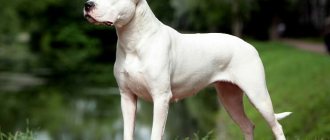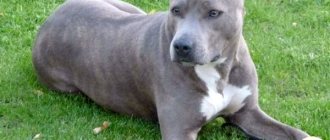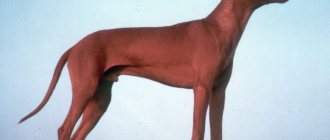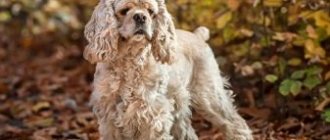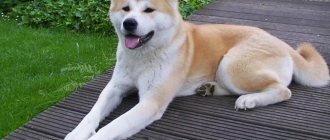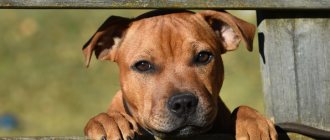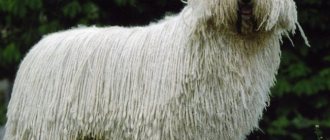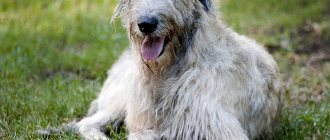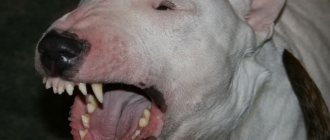According to historical data on the origin of different breeds, fighting dogs do not have a single ancestor. According to the classification, they all belong to the Wolf family and, according to one version, they descended from wolves and jackals. Through selection and production of hybrids, fearless pets were bred, capable of quickly entering into battle, protecting themselves and loved ones, and fighting for their owner.
Dogs took part in gladiator fights, accompanied people on campaigns, and were an integral part of attack tactics and territory protection.
In ancient times, Molossians were valued; in the Middle Ages, bulldogs appeared, then a group of terriers appeared. In the last two centuries, history has allowed the possibilities of interbreeding to expand. Representatives of herding groups and typical hunting dogs joined the fighting dogs.
At the same time, hybrid forms of breeds acquired their final features. This was facilitated by the organization of exhibitions and other events, and the development of special international standards.
There is no single definition of “fighting dog” in the world; it is very conditional. This includes those representatives who, based on their character traits, abilities, learning ability and appearance, are suitable for being allocated to groups.
Dogs are reliable guards and defenders with a special character, where the leading feature is innate aggressiveness. During the selection process, the ability to quickly attack and attack decreased. This does not mean that all Wolfs have turned from fighting pets into good-natured people.
We must always remember that behavioral traits and characteristic features are inherent in many people. How they will manifest themselves, when, why, no one knows. Owners should be properly trained, taking precautions, and suppressing the pet's desire to take a leading position.
American Staffordshire Terrier (Amstaff)
A tireless athlete, a brilliant intellectual and a good-natured cheerful fellow - this is the impression a well-mannered Amstaff makes. Staffordshire Terriers are easy to train and try their best to please their owner. Sometimes it seems as if the dog reads minds! But the motivation should only be positive - violence and rudeness spoil the character of the animal.
Character and education
The nature of the “boules” is specific. They have an extraordinary mind and can read a person’s thoughts. From the first days, it is necessary to extinguish the foci of their aggression and direct the strength and energy of the dogs in the right direction. With proper upbringing of a puppy and its early socialization, a good friend and protector will grow up.
Bull Terriers are hyperactive and require long-term physical and mental training. They are willful and stubborn. They are not characterized by cowardice and betrayal. Ready to protect the owner at the cost of life. Affectionate in the family, loyal to children and powerful in the world around them. Any representatives of the fauna are treated as prey. Walking without a leash is prohibited.
Dogo Argentino
The ancestors of the Dogo Argentino accompanied the Spanish conquistadors on military campaigns. The snow-white hidalgo has not lost his aristocratic dignity even today - the dog rarely gives a voice and attacks silently. Dogo Argentinos are unshakably confident and even stubborn, but at the same time they adore their owners and need attention, affection and encouragement.
Dogue de Bordeaux (French Mastiff)
One of the oldest guard breeds in Europe comes from the Kingdom of Aquitaine. In the Middle Ages, these dogs guarded butcher shops and fought bulls for the amusement of the public. When cruel fun was banned, the affectionate and playful Bordeaux became companions and family friends, but did not lose their protective qualities. The dog relentlessly follows its owner and is always ready to defend him.
Reproduction and lifespan
Breeding French bulldogs is a difficult task due to the low productivity of natural mating and complex births of females. The gestation period for puppies is 63 days.
Bulldogs undergo caesarean sections due to the puppies' very large heads. Without the help of a veterinarian, she may die. You should take care of a preliminary ultrasound to know how many newborns to expect. There were cases of difficult births when puppies remained in the uterus and died.
It is advisable for owners of French bulldogs to decide in advance whether they will deal with the issue of their pet’s offspring. Please note that during puberty, puppies become more irritable. Sterilization of animals restores peace and balance. The life expectancy of dogs is 10-12 years, if you take care of your pet's health and provide proper care.
Bullypit (American Bully)
The youngest fighting breed, which made its name at the end of the last century. The character of a bodybuilder dog successfully combines the sports passion of a pit bull and the affection of a bull terrier. A stocky, squat dog with a big brave heart is endowed with heroic strength, but it is extremely difficult to provoke him into aggression. The dog's self-control deserves admiration - for the sake of its beloved owner, the bullypit will endure anything!
What you need to know about fighting breeds
Cynological organizations do not recognize the concept of “fighting breed”; it is a way of life given to the dog by the owner. Since ancient times, breeding such animals has been necessary for hunting, baiting wild animals, and participating in wars. The fighters have a hot temperament, fearlessness, a low pain threshold, a powerful jaw, and fighting skills.
First, the owner must decide whether the pet will participate in real battles in the ring or grow up as an ordinary family pet.
Fighting dogs will require compliance with simple but important maintenance rules:
- timely training in basic commands (sit, come to me, bring, no);
- strict obedience;
- using a short leash with a muzzle for walking.
A small dog will not have the qualities of a fighter from birth; this is the result of long training, education, training, coaching. The fighting dog is dangerous to others, the owner needs to remember this.
Bullmastiff
In England in the 17th and 18th centuries, bullmastiffs tracked poachers on lords' lands. The breed’s excellent sense of smell and watchdog qualities are highly valued in the police and army, and at home it is simply a reliable friend and playmate. The fight for leadership is not in the nature of the bullmastiff, but he has his own opinion about everything in the world, which he stubbornly defends. You can convince a dog only with patience, not brute force!
About the reputation of such dogs
Participation in dog fighting is paid. The owner will have to pay money for renting the ring, the work of a judge, and a veterinarian. But there are a lot of people who want to watch the fights, so the winning dog will bring the owner a good prize fund of 100 thousand rubles or more.
Expert opinion
Anna Abramenko
An avid dog lover. Experience in veterinary medicine since 2009.
Ask a Question
Animal rights activists are spreading rumors about the frequent death of dogs in the ring, but the organizers deny such beliefs. Veterinarians and owners do not allow such cases.
The negative reputation that fighting dog breeds have is due to inexperienced or irresponsible owners. The danger of unmotivated aggression, venting anger on people or other animals in dogs arises due to the lack of proper physical activity, accumulated excess energy, as well as as a result of neglect of training and training.
Bull Terrier
Small but brave - that’s what the bull terrier is all about! A small but well-built dog shows miracles of courage, endurance and perseverance, and its powerful grip allows it to defeat even an opponent who is superior in strength. In peaceful life, the Bull Terrier is an energetic, quick-witted and cheerful companion who strives to participate in all family affairs.
Is it worth getting a fighting dog?
A fighting dog is naturally endowed with traits that are difficult to handle without training. If you decide to get a pet, then consider the following factors:
- Each breed has its own positive and negative traits. You should definitely know them before purchasing.
- The future owner is distinguished by courage, determination, and the ability to make quick and correct decisions.
- A genetic predisposition to aggression can manifest itself at any time: during a walk, when you are exercising, if another dog approaches. Behavior must be constantly monitored.
- War dogs are distinguished by their endurance and mobility. This is supported by regular physical training and long walks.
- Some dogs are prone to obesity and rapid weight gain. This is regulated by proper nutrition.
If you decide to get a fighting dog, you take full responsibility for proper upbringing in an urban environment. Socialization is absolutely necessary, including special obedience classes with dog handlers.
Spanish Mastiff
Even among the huge Molossians, the Spanish Mastiff looks like a hero - males reach a weight of 120–130 kilograms. The dog is fully aware of its power and does not stoop to petty squabbles, but will not offend its owner. The Spanish Mastiff is strict and cold with strangers, but around the family it is cheerful and playful. And the impregnable giants adore children and forgive the little naughty ones absolutely everything!
Features of training
Fighting dogs need to be trained from a very early age . These breeds are genetically programmed to be aggressive and want to get into fights, so puppies need socialization as early as possible. The pet will have to devote all his free time, walk with him every day for 2-3 hours (exclusively in a muzzle and on a leash), and provide him with the necessary level of physical activity. In the process of education and training, you must adhere to the following rules:
- always show your dominant and leading position, not allowing the dog to insist on its own (the owner must be an indisputable authority);
- if necessary, show rigidity and rigor;
- give commands correctly, clearly and firmly;
- do not use physical violence.
Fighting dogs must be trained
You should not leave small children with a fighting breed dog, as children can provoke a surge of aggression.
It is best to entrust the training of a dog prone to aggression to an experienced instructor who has experience in handling such animals . But the training process is not limited to one or even two completed courses; the dog will have to be trained throughout its life, while constantly keeping it under strict and vigilant control.
Ca de bou (Mallorcan Bulldog)
The ancient fighting dog breed came to Spain from the Balearic Islands. In the old days, ca de bos took part in bullfights along with bullfighters, and in our time they delight their owners with cheerful pranks and a light, sunny character. At the same time, the Mallorca Bulldog has not lost its protective qualities - the dog can easily pull down a bully and drive the uninvited guest out of the yard without showing excessive aggression.
Fighting Bulldogs (English, French, American)
Bulldogs are a very strange breed in selection. Greyhounds, mastiffs and even Pugs participated in its creation. The result was small, short-legged dogs with a flat, upturned muzzle, but a death grip. They were used as fighting and baiting weapons, and later as guards.
There were 3 different branches:
- Previously bred - English Bulldog .
- The American (Ambul) was distinguished by increased aggressiveness and the largest size, because it was not mixed with Pugs.
- French bulldogs , in turn, are considered miniature. They are most often bred as ornamental.
All Bulldogs have increased aggressiveness towards their relatives, but a peaceful attitude towards people . They love children, are active and cheerful on walks, and are resistant to any weather conditions. However, like all fighting breeds, they need serious training.
Cane Corso
Restrained and calm in appearance, when you get to know each other closely, Cane Corso dogs amaze you with their tender affection for their owner. They are wary of strangers, but do not show unmotivated aggression. With proper training, the Cane Corso will make an excellent bodyguard. The dog is easy to train, calculates risks well and, in the event of a real threat, acts decisively and with lightning speed.
Other fighting breeds
In addition to molossoids and similar dogs, large mountain animals, there are other breeds whose character and physical characteristics clearly indicate a fighting nature.
American Akita
A variety of originally Japanese breed that was brought to America. Unlike its brother, the American Akita is not a hunting dog, but a guard dog. Since the breed has been improved through selection, it has a softer character towards humans. Japanese representatives are unfriendly, capricious, and difficult to train.
The Americans performed excellently in security. Akitas follow the instructions of the owner, do not attack first, and do not show excessive aggression. The only negative is its cute, friendly appearance, which does not scare an attacker.
Now many lovers are eager to have a fighting breed, not only for protection, but also as a deterrent to others. However, such dogs are intended only for experienced people who have had the opportunity to communicate with similar animals and know how to train them.
Rottweiler
The dog is considered quite dangerous and even bloodthirsty. Without proper training and education, it can be aggressive. This breed is even included in the list of especially dangerous in such countries as: Ukraine, Spain, France, Italy, Romania. Not everything is as bad as it would seem, because with proper upbringing, the Rottweiler will become an excellent companion and faithful guard , an example of this is the prevalence of the breed in Russia.
It has large dimensions: height about 70 cm , weight - 45-50 kg . Rottweilers have high intelligence, so with the right approach, training them is not difficult, the main thing is not to let the dog dominate, and to be able to show who is the boss.
Read about how to properly train a dog in the article: “Training a puppy: effective methods from dog handlers, learning commands at home.”
Neapolitan Mastiff
Due to its impressive dimensions and many folds on its face, the Neapolitan Mastiff seems like a creepy creature from hell. In ancient Rome, the ancestors of the formidable Neapolitans took part in gladiatorial battles and military campaigns. Thousands of years of selection have balanced the protective instinct and rage towards the enemy with strong nerves and the docile nature of the breed. In the family circle, these phlegmatic giants are kind, affectionate and generous.
Group of fighting terriers
This is not a pure breed group. The word “terrier” itself is translated as “earthen” or “burrow”. The dogs were bred exclusively for hunting; they are small in size and cute in appearance.
As for fighting species, their ancestors are not only Terriers, but also world-famous Bulldogs. The breeds were actually bred for fighting, most often dog fighting. But in the mid-19th century, this entertainment became forbidden. Therefore, all such fighters were subject to selection work, during which the characters of the dogs were radically changed.
Now most of the former bloodthirsty dogs have become cute pets. However, fighting terriers are often used for service.
Bull Terrier
The shortest of the group, it reaches 30-40 cm at the withers and weighs 8-13 kg. These are small, stocky dogs with pronounced, well-developed muscles. A distinctive feature is an elongated convex skull and a round bridge of the nose, which gives the animal a terrifying appearance. A fighting feature is large teeth in a full set (42: 20 in the upper jaw and 22 in the lower jaw). Acceptable colors: white or colored (brindle, brown, red), spots are allowed.
The character of the Bull Terrier depends on heredity. Those who have never kept the breed often talk about the disadvantages. If the litter is of high quality and without deviations, then the puppy will develop normally, without outbursts of aggression or anger towards humans. Basically, Bullies are affectionate to their owners, love children, they are active and playful. Good physical shape makes them unsurpassed defenders; they treat strangers with caution, and with proper training they will never be the first to attack.
Among the minuses, it is worth considering jealousy, intolerance of loneliness, and cockiness. These pets will never miss an opportunity to show their leadership among other pets. To avoid this, you need to properly socialize the animal from the first days of training: introduce it to people, to tanks, and walk it in noisy places.
Animals are rarely kept outside; they are intended for apartment and home keeping. Due to their short fur, Bullies are susceptible to sudden climate changes and cannot tolerate severe frosts or abnormal heat. They are easy to care for, but require long walks and constant training.
Staffordshire Bull Terrier
A fighting breed bred from Molossian dogs, bulldogs and terriers for fighting. Breeders were in dire need of a compact, but strong and scary animal, as a result of which the Bull Terrier appeared. At the withers he is 35-40 cm and weighs 11-17 kg . Due to their small size, dogs were the best figures in dog fights held in closed pubs and restaurants.
Externally, Stafford is short, short-legged, but strong and muscular. The owners note that the animal can smile and be sad, this is due to the accumulation of wrinkles on the face and head. Dogs' ears are semi-erect, long, but not large. These Bulls look more like Bulldogs than Molossers.
Dogs have not been used as fighting dogs for a long time; their character has been completely changed to suit the desires of dog lovers. Therefore, Staffbulls are considered one of the most loyal and best family fighting dogs. They are companions rather than working service pets.
Dogs are loyal to their owner, love and protect children, and are non-aggressive towards people, even strangers . Genetically, Bulls may not like their brothers, but they are not aimed at eliminating the enemy. Representatives of the breed strive to demonstrate their leadership and establish themselves in the team through physical superiority.
Despite the fact that the breed is completely human-oriented, Staffbulls are often stubborn and try to take a dominant position in the house. They need serious education and physical activity, otherwise the animals are unpretentious.
American Pit Bull Terrier
Daughter breed of the Staffordshire Bull Terrier. It was developed in America after fight clubs for animals were banned in England. Bull Terriers were brought to the continent to improve their skills. As a result of selection, the Pit Bull Terrier, or Pit Bull for short, appeared.
The breed is characterized by extreme instability in appearance and growth. At the withers, individuals reach from 43 to 53 cm , resembling either bulldogs or terriers. A characteristic feature is a fit body and long muscular legs . The muzzle can be either short, wide or elongated. The color can be solid or brindle (except merle).
Despite its high popularity in America and the world, active use in the 19th and 20th centuries, the breed is still not recognized by the world canine organization. Dogs do not have a clear standard; breeding, to a large extent, is carried out randomly. This is why Petes can differ greatly in appearance and character.
Pit bulls are the most aggressive and uncontrollable of the fighting terrier group, all because the development of character is difficult to keep track of. Not every nursery has family books, so it is difficult to analyze the shortcomings of a particular puppy’s ancestors. Dogs are prohibited in many EU countries and America. Other states have introduced strict rules for keeping and walking the breed, because it is classified as potentially dangerous.
In fact, healthy adequate Pit Bull Terriers do not have aggression towards humans. Their anger is directed at animals, in particular dogs. Well-mannered Pete will be affectionate and friendly even to strangers.
American Staffordshire Terrier
American Staff or Amstaff is a breed branch originating from the Pit Bull. Unlike their brothers, Amstafs are registered and recognized by the world. They have a softer character, although they are still not as kind as Staffbulls. Their direct goal is to protect themselves and their owner, and eliminate the threat.
They are similar in appearance to Pita: long-legged, tall (43-48 cm), strong and muscular. However, their type is terrier. The muzzle is not wide and elongated with a deep stop and a minimum of wrinkles. Unlike Staffbulls, Staffies' ears are cropped. In addition, this breed cannot have white, liver or tan colors.
By character, Amstaf is a true leader, a winner . Animals are hardy, strong, with a high pain threshold and a strong nervous system. They show good results in training and are better suited than others for service in military structures. Dogs are friendly to people, although strangers should stay away from them.
Central Asian Shepherd Dog (Alabai)
Alabai is the national pride of Turkmenistan and one of the oldest breeds in the world. At dog fights, the strongest and most persistent fighters were selected, who would not be afraid of either a wolf or a bear. There are legends about the nobility of the breed: Turkmens claim that in the ring the Alabai does not finish off a defeated opponent. The dog will protect its owner to the last drop of blood, but will not tolerate rudeness and injustice.
Pros and cons of the breed
Like all dogs, the English Bull Terrier has its own advantages and disadvantages.
| pros | Minuses |
| Has intelligence | Difficult to train |
| Suitable for apartment living | Does not tolerate frost and heat well |
| Shedding is not pronounced | Presence of genetic diseases |
| Easy to care for | Suitable for experienced dog owners only |
| Playful and active | Difficult to educate, complex character |
| Acts as a companion | Prone to aggression |
| Has security and protective qualities | Doesn't get along with other pets |
| Strong and dexterous | Jealous, capricious, vindictive |
| Fearless | Free range is prohibited |
Presa Canario (Dogo Canario)
The brutal, handsome Dogo Canario is the embodiment of strength and dignity. A sensitive guard will not make a fuss over a trifle and will not attack the first person he meets - the breed is famous for its endurance and prudence. At the same time, wariness does not prevent the Presa Canario from enjoying life: dogs love to play with their owners and are not averse to playing pranks with children.
Bull Terrier – Gladiator in a White Tailcoat
England is considered the birthplace of all rat-faced dogs. This breed was developed by James Hincks. Back in the 19th century, he introduced everyone to a white dog with an ordinary appearance. After some time, a fighting bull terrier of a different color appeared. Several completely different breeds took part in the selection:
- English bulldog;
- Dalmatian;
- white English terrier.
Bull Terrier dog
For many years it was believed that keeping a house of this breed was a sign of good taste. The rat-like dog was a huge success among almost all dog breeders in England. The breed standards are as follows:
- muscular torso;
- height up to 55 cm;
- weight up to 30 kg;
- long elongated head with a shark mouth;
- powerful jaws;
- small tail;
- a big nose.
The color can be varied, but most attention is paid to white wool. A dog with a muzzle like a rat, despite its muscular build, has sufficient agility and can jump high
Bull Terrier resting
Head structure
Almost immediately, a dog with a rat's face catches the eye due to the unusual egg-shaped head. Many people find her attractive. The features are as follows:
- the muzzle immediately catches the eye due to the powerful jaw, the teeth are very strong;
- the head is set low on a muscular and strong neck;
- The ears are triangular and erect. They are located quite close to each other;
- the nose is large. Many people argue that a dog with a long nose resembles a rat and is therefore unattractive;
- The eyes are very small and set wide apart, which is why many people think that the dog looks like a pig.
Note! A pit bull with a sharp muzzle is not an elegant dog. The dog's habits look unusual due to its massive body and interesting face.
Bull Terrier head
Coat and colors
Pit bull terriers or pit bulls must be white in color according to the standards. Skin pigmentation largely determines a dog's attractiveness. In addition, wool can be of other shades:
- red color without any markings. In this case, shades can differ significantly, even dark brown;
- black color is less common than others;
- Two-color bull terriers differ from others in that they have large areas of contrasting color. There are a variety of combinations, for example, black and red. White patches spread over the face, paws or chest. Ideally, they should account for no more than 50% of the color;
- There is also a three-color color variant. It is represented by a combination of black, red and white. In most cases, a black tint predominates; white should be no more than 50%. The red color accounts for the least, it appears on the muzzle or chest, as well as on the limbs.
- brindles were not immediately recognized, but eventually they began to be considered at exhibitions. The color of such a dog is represented by a combination of red and dark stripes. In some cases there are white markings.
The coat is thick and short, so a dog with a large nose is also suitable for keeping in an apartment. The pet does not require careful care.
Important! Almost all dog breeders claim that blue color is absolutely unacceptable and such individuals should not be bred.
Tosa Inu (Tosa Token, Japanese Mastiff)
The only fighting dog breed from Japan fights using the sumo technique - it does not tear or crush the enemy, but delicately lays him on his shoulder blades. The animal behaves with true Japanese composure - even in the heat of a fight it will not make a sound. With his owner, the four-legged samurai is polite, helpful and reserved, but avoids violent outpourings of feelings.
Group of fighting mastiffs (Molossoids)
It is difficult to imagine a dog from the Molossoid group as a domestic sofa dog. Indeed, mastiffs were bred to serve humans: hard work, baiting animals, gladiator fights. They were trained for fierce battles, so modern representatives of the breeds have still not lost their former courage.
A common feature for all mastiffs is size. Animals are large and dangerous for a stranger or dog. They require a lot of space, training, food and attention.
